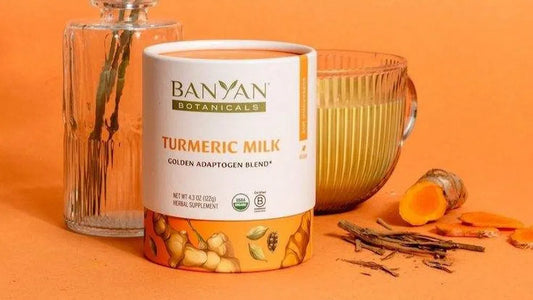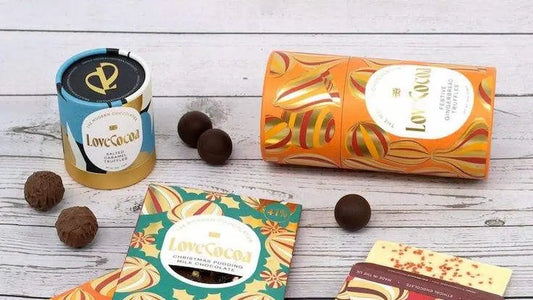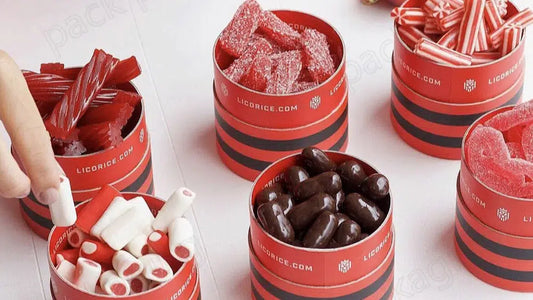How to Create Pretty Cosmetic Packaging Paper Tubes
Compartir
In the competitive realm of cosmetics, packaging serves as the first impression and a crucial touchpoint for consumers. It transcends mere functionality by embodying brand identity, values, and aspirations. For cosmetic brands, packaging is not just a vessel but a canvas that communicates style, quality, and innovation. Crafting cosmetic packaging paper tubes involves a delicate balance of creativity, practicality, and consumer appeal. It's about capturing attention, sparking desire, and fostering brand loyalty through visual and tactile experiences.
Reflecting Brand Identity and Enhancing Visual Appeal
Cosmetic packaging is the ambassador of brand identity on store shelves and in digital marketplaces. Whether sleek and minimalist or bold and vibrant, packaging must instantly convey the essence of the brand it represents. Strategic use of colors, typography, and materials helps align packaging with brand values and consumer expectations. For instance, luxury brands often opt for sophisticated finishes like embossing or foil stamping to convey exclusivity and elegance. On the other hand, eco-conscious brands may use recycled materials and earthy tones to signify sustainability and environmental stewardship.
Consistency across different product lines is another challenge. A brand's packaging should create a cohesive visual identity across its entire range of products while accommodating variations in size, shape, and function. Techniques such as maintaining a unified color palette, incorporating consistent design elements, and prominently featuring the brand logo can help achieve this harmonious balance.
Ensuring Consistency across Different Product Lines
Maintaining brand consistency across varied packaging formats is akin to conducting a symphony with diverse instruments. Each product should harmonize visually while catering to unique functional needs. Techniques such as using a consistent color palette, typography, and iconography across all packaging formats can achieve this symphonic unity. This not only strengthens brand recognition but also enhances consumer loyalty by creating a cohesive brand experience.
Achieving this consistency requires meticulous planning and design execution. Brands must establish clear guidelines that govern how their visual identity translates across different product categories. This includes standardizing elements such as logo placement, brand colors, and typography, ensuring they remain coherent regardless of the packaging size or shape.
Achieving High-Quality Printing and Finishing
The allure of cosmetic packaging often hinges on impeccable printing and finishing. High-quality printing elevates the brand perception, conveying a sense of luxury and attention to detail. Factors like selecting the right printing techniques—whether it's offset, digital, or silk-screen—and choosing finishes such as matte, gloss, or embossing, can make or break the visual appeal. Premium printing and finishing aren't just about aesthetics; they communicate quality and care to the discerning consumer.
To achieve high-quality printing and finishing, brands must work closely with experienced packaging suppliers and printers. This collaboration ensures that the chosen printing techniques align with the packaging material and design specifications, achieving optimal results. Moreover, investing in advanced printing technologies and skilled craftsmanship can significantly enhance the overall look and feel of the packaging. Whether it's enhancing color vibrancy, ensuring sharp detail in text and graphics, or adding tactile finishes that engage the senses, every aspect contributes to creating packaging that stands out on the shelf and resonates with consumers.
Balancing Aesthetic Appeal with Practical Considerations
Beauty should never compromise utility, especially in cosmetic packaging. A balance must be struck between visual appeal and practical considerations like durability and product protection. Innovative design solutions such as incorporating protective inserts or choosing resilient materials without sacrificing aesthetics can achieve this delicate equilibrium. After all, a stunning package that fails to protect its contents is like a gorgeous facade hiding a fragile structure.
Achieving this balance requires a deep understanding of both design aesthetics and functional requirements. Designers must consider factors such as product fragility, transportation conditions, and consumer usability when developing packaging solutions. By integrating protective features seamlessly into the design, such as using sturdy paperboard or biodegradable materials, brands can ensure that their packaging not only looks appealing but also maintains product integrity throughout its lifecycle.
Dealing with Limitations in Design Options from Suppliers
Navigating the realm of packaging suppliers can sometimes feel like choosing from a limited menu at a gourmet restaurant. However, constraints breed creativity. Understanding the limitations and capabilities of suppliers allows designers to innovate within those boundaries. Collaborating closely with suppliers, exploring alternative materials, and leveraging their expertise can unlock surprising design possibilities while maintaining quality and cost-effectiveness. Embracing these challenges can lead to breakthroughs in packaging design that set brands apart in the competitive market.
Finding the right balance between creative vision and supplier capabilities is essential for successful packaging design. By fostering strong relationships with suppliers and engaging in open communication, brands can navigate design limitations more effectively. This includes understanding material availability, production capabilities, and technological advancements that can influence design feasibility. Moreover, exploring sustainable and innovative materials not only expands design options but also aligns with growing consumer demand for eco-friendly packaging solutions. By embracing supplier constraints as opportunities for innovation, brands can create packaging that not only meets but exceeds expectations, enhancing brand perception and consumer satisfaction.
Managing Costs and Premium Materials
Creating luxurious packaging that doesn't break the bank requires strategic cost management. It's about making informed choices—selecting premium materials where they matter most while opting for cost-effective alternatives elsewhere. Negotiating bulk discounts, optimizing packaging dimensions to minimize materials, and exploring sustainable options can all contribute to managing costs without compromising on perceived value. By balancing budget constraints with the desire for high-quality packaging, brands can achieve a competitive edge while maintaining profitability.
Cost management in packaging design involves a holistic approach that considers both immediate expenses and long-term benefits. Brands can achieve cost efficiencies by standardizing packaging components across product lines, leveraging economies of scale, and streamlining production processes. Additionally, exploring innovative packaging solutions, such as lightweight materials or modular designs that reduce material waste, can lead to significant cost savings over time.
Addressing Color Accuracy and Consistency
In the world of cosmetics, where shades matter deeply, color accuracy is paramount. From foundation tones to lipstick hues, precise color reproduction ensures brand integrity and consumer satisfaction. Leveraging advanced color management tools, conducting regular quality checks, and partnering with printing experts who understand the nuances of cosmetic colorants are essential steps toward achieving consistent color accuracy in packaging.
Achieving color consistency requires meticulous attention to detail throughout the packaging production process. Brands should establish rigorous color standards and conduct thorough color testing across different printing and finishing techniques. Collaborating closely with printing partners to calibrate equipment and monitor color output ensures that packaging colors match the intended brand palette. Additionally, investing in color measurement devices and software can streamline color management workflows, facilitating accurate color reproduction from initial design concepts to final production. By prioritizing color accuracy, brands can uphold their visual identity, meet consumer expectations for product consistency, and differentiate themselves in a competitive market landscape.
Enhancing Overall Product Experience through Packaging
Packaging isn't just about protection and promotion; it's about creating an unforgettable consumer experience. Think of unboxing moments that delight, tactile textures that intrigue, and functional designs that simplify. From magnetic closures that whisper luxury to sustainable materials that resonate with eco-conscious consumers, every element should contribute to a memorable brand interaction that extends beyond the product itself.
The product experience begins with packaging design, which serves as the first point of contact between consumers and brands. Brands can enhance the overall product experience by designing packaging that engages multiple senses and aligns with consumer expectations. This includes incorporating tactile elements such as embossed textures or soft-touch finishes that invite touch and exploration. Functional features, such as easy-open mechanisms or compartmentalized interiors, can enhance usability and convenience, further elevating the consumer experience. Moreover, storytelling through packaging design—whether through visual narratives or eco-friendly messaging—creates emotional connections and fosters brand loyalty.
Conveying Brand Values and Messaging Effectively
Packaging is a silent storyteller, conveying brand values and messaging at first glance. Whether it's through eco-friendly materials signaling a commitment to sustainability or elegant design reflecting a brand's timeless elegance, every detail speaks volumes. Aligning packaging design with brand storytelling involves thoughtful choices—using symbols, colors, and materials that resonate with the target audience and reinforce the brand narrative.
Effective brand messaging through packaging design requires a deep understanding of consumer preferences and market trends. Brands should articulate their core values and brand personality through visual elements and messaging on packaging. This includes integrating sustainable practices, such as using recyclable or biodegradable materials, to align with environmentally conscious consumers. Clear and concise communication of product benefits, usage instructions, and brand mission statements can also enhance brand credibility and consumer trust. Moreover, leveraging packaging as a platform for storytelling—whether through imagery, typography, or interactive features—creates memorable brand experiences that resonate long after purchase.
Handling Stakeholder Feedback and Adjustments
Designing packaging is a collaborative journey where stakeholder feedback plays a crucial role. Whether it's input from marketing teams, insights from production specialists, or feedback from focus groups, each perspective enriches the design process. Embracing constructive criticism, iterating designs based on feedback, and maintaining open lines of communication ensure that the final packaging not only meets but exceeds expectations.
Engaging stakeholders throughout the packaging design process fosters alignment and ensures that diverse perspectives are considered. Brands should establish clear communication channels and feedback mechanisms to solicit input from internal teams, external partners, and target consumers. This collaborative approach facilitates continuous improvement and enables brands to address potential issues or opportunities early in the design phase. Iterative prototyping and testing can validate design concepts and gather actionable insights, guiding refinements to packaging aesthetics, functionality, and messaging. By embracing stakeholder feedback as a catalyst for innovation, brands can optimize packaging designs, enhance consumer engagement, and achieve sustainable business growth.
Future Trends and Innovations in Cosmetic Packaging to Watch
Looking ahead, the future of cosmetic packaging promises exciting developments—from smart packaging that enhances user experience to sustainable innovations that reduce environmental impact. As technology and consumer preferences evolve, staying ahead of the curve will be key to maintaining competitive advantage in the dynamic cosmetics industry.
Ready to elevate your cosmetic packaging game? Whether you're a niche brand or an industry titan, Esytube.com is here to partner with you in creating packaging that captivates, convinces, and converts. Explore our range of customizable paper tubes and unleash your brand's full potential today.
With Esytube.com, transform your packaging from ordinary to extraordinary. Because great packaging isn't just pretty—it's powerful.




